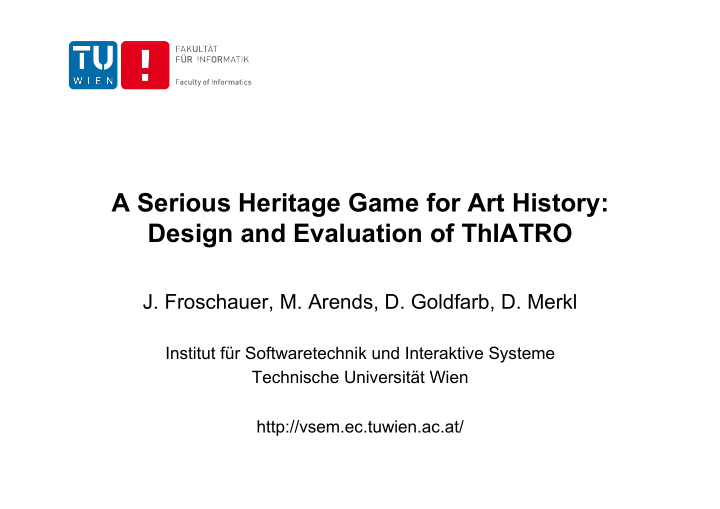



A Serious Heritage Game for Art History: Design and Evaluation of ThIATRO J. Froschauer, M. Arends, D. Goldfarb, D. Merkl Institut für Softwaretechnik und Interaktive Systeme Technische Universität Wien http://vsem.ec.tuwien.ac.at/
Agenda Motivation Design of ThIATRO Evaluation Conclusions
Motivation Engage players with art history Focus on visual exploration of artworks Compare and contrast of artworks
Motivation Online game that aims at raising the interest in art history and cultural heritage Helps students learn art history Tangible attributes of cultural heritage
Design of ThIATRO 3D game Browser based (Unity3d plug-in) Puzzle game
Learning Content - Game Levels Genres (Tutorial) Iconography Famous Topics in Art Perspective Eras of Art Lighting and Shading Specific Artist (Caravaggio)
Data Source Web Gallery of Art (WGA) http://www.wga.hu/ European painting and sculpture from 11th to mid-19th centuries Number of artworks: 28.400
The Case of 3D Immerse the player into an exhibition by recreating 3D virtual museums Raises the curiosity to engage with art and thus creates a persistent idea of art historical concepts in the player’s minds vs.
Making of ...
Making of ...
Making of ...
Making of ... +
Making of ...
Design Process Genre Core Mechanics Rules Probing the VW: Fulfill task, “creativity”, looking, moving, 10p correct “observation”, investigating, answer, “memorization” comparing, -5p wrong recalling answer Puzzle game
Evaluation 4th grade 20 pupils (12 female, 8 male), approx. 14 years old Contact person: Mag. a Susanne Schatz, form teacher 2 hours arts class at 15 April 2011
Methodology Control Group / Experimental Group to get a comparison to prevalent teaching methods Checking facts about artists, paintings, years of creation... Checking, if ThIATRO changes the way a person perceives art
Aesthetic Response How a person feels about a work of art How can one best study or measure this response? 5 Aesthetic Stages, defined by: Abigail Housen (2007). Art Viewing and Aesthetic Development: Designing for the Viewer. From Periphery to Center: Art Museum Education in the 21st Century, Chapter 21. The National Art Education Association, Reston, VA, USA.
Aesthetic Stages Stage 1: Viewers are listmakers and storytellers, making simple, concrete, observations Stage 2: includes the knowledge of the natural world, and the values of their social and moral world Stage 3: Identify the work as to artist, school, style, time, and provenance Stage 4: Viewer lets the meaning of the work - its symbols – emerge Stage 5: Viewers have established a long history of viewing and reflecting about art
Hypothesis Control Group / Experimental Group, pupils randomly assigned Hypothesis: ThIATRO changes the aesthetic response of a person and allows him/her to perceive art on a deeper level Pre- Gameplay/ Post- Pre-Tagging Post-Tagging Questionnaire Teaching Questionnaire 1 2 3 4 5
Methodology AS1 : simple, concrete, observations and feelings AS2: using perceptions and knowledge of the natural world, for example naming persons / topics that do not imply art historical knowledge AS3: Identify school, style, time, provenance, persons, topics, ... avg. pre playing/learning avg. post playing/learning
Results – Pre-Tagging Average Experimental: 1.18 Average Control: 1.29
Results – Post-Tagging Average Experimental: 2.30 Average Control: 2.32
Results - Summary Both approaches changes the aesthetic response of a person and allows him/her to perceive art on a deeper level 30-minutes playing/teaching too short to change person‘s view on art permanently
Pre-Questionnaire Moderately interesting in: learning games, M = 2,75, SD = 0,85 art history, M = 2,65, SD = 1,18 M = 2,70, SD = 1,13 and visiting museums
Post-Questionnaire M = 4,60, SD = 0,52 Exp Level of fun M = 3,90, SD = 0,74 Con M = 3,90, SD = 0,57 Exp „I will keep on dealing Con M = 2,20, SD = 0,79 with art history“ M = 3,50, SD = 0,71 Exp Sparking interest Con M = 3,00, SD = 1,05
Conclusion Exclusively playing is not the solution Games do not replace teachers The key is to make people learn at home!
A Serious Heritage Game for Art History: Design and Evaluation of ThIATRO J. Froschauer, M. Arends, D. Goldfarb, D. Merkl Institut für Softwaretechnik und Interaktive Systeme Technische Universität Wien http://vsem.ec.tuwien.ac.at/ http://www.thiatro.info/
Recommend
More recommend